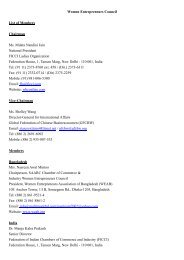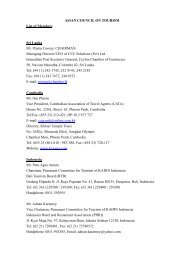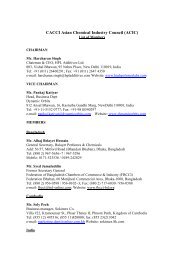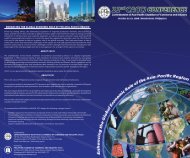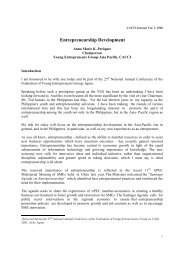The Importance of Traditional Techniques - cacci
The Importance of Traditional Techniques - cacci
The Importance of Traditional Techniques - cacci
You also want an ePaper? Increase the reach of your titles
YUMPU automatically turns print PDFs into web optimized ePapers that Google loves.
CACCI Journal, Vol. 1, 2006it is concentrated on ET itself. Many studies <strong>of</strong> ET policies not only ignore but also deny theusefulness <strong>of</strong> traditional techniques and even blame past policies as having inspired localSMEs to stick to obsolete techniques. <strong>The</strong>refore, almost no study has been made abouttraditional techniques working in tandem with ETs. Because <strong>of</strong> the absence <strong>of</strong> relevant Japanesecase studies, this article is based on my own past studies.Plan <strong>of</strong> this articleThis article discusses the role <strong>of</strong> traditional techniques in the era <strong>of</strong> ET in Japan. Section2 historically reviews the imbalance (and the resulting dual structures) between modernizedand underdeveloped technologies that have resulted from rapid innovation in Japan in thepast. 1,2 Section 3 discusses the dilemmas <strong>of</strong> recent innovation policies with respect to thesedual structures and the weaknesses <strong>of</strong> recently developed ETs in comparison to traditionaltechniques. 3,4 Section 4 presents proposals to solve the resulting problems.Dual structures in the pastResult <strong>of</strong> rapid catch-up policiesIn the late 19th century, the government <strong>of</strong> Japan sought rapid modernization to rivalWestern powers in military aspects. For this purpose, the government promoted moderntechnologies for munitions <strong>of</strong> war, such as steel production and shipbuilding, leaving other industriesat underdeveloped levels.At first, Japan exported agricultural products, such as raw silk, and handicrafts, such asdolls.In the early 20th century, the spinning industry was highly developed in Japan and filledthe gap after England retreated from Asian markets such as India and China. This acceleratedthe development <strong>of</strong> looms. S. Toyota invented a series <strong>of</strong> automatic looms and raised theproductivity <strong>of</strong> the spinning industry <strong>of</strong> Japan over its English rivals. Thus, in the pre-warperiod, the military and spinning technologies <strong>of</strong> Japan achieved top world levels, while othertechnologies were left underdeveloped.But the development <strong>of</strong> looms stimulated the development <strong>of</strong> machinery in general. <strong>The</strong>army promoted the conversion <strong>of</strong> loom technologies to automobile technologies. Supportedby the army, Nissan and Toyota began production <strong>of</strong> trucks and motor cars in the 1930s, butthe technologies for comfortable passenger cars remained underdeveloped.A similar imbalance was seen in electric technologies. Technologies for powergenerators and military communication equipment were developed, while technologies forhome electrical appliances remained underdeveloped.In the USSR, J. Stalin launched the first five-year plan in 1928. This plan hoped todevelop the entire economy through a pull effect from the heavy and chemical industries.Indeed, the products <strong>of</strong> the heavy and chemical industries helped light industries by providingmachine tools, high quality materials and the like. It also helped agriculture by providingtractors, agricultural chemicals and others.2





